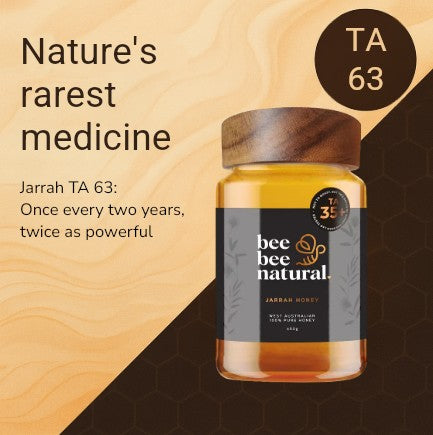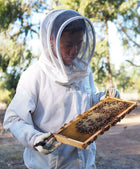Jarrah Honey Singapore: Ethical Harvest & Benefits

Singaporeans love honey not just for taste but for health. Among premium honeys, Jarrah honey stands out – and Bee Bee Natural delivers the finest Jarrah (from WA’s Jarrah forests) right to Singapore. But what really sets this honey apart is how it’s made. This post mixes story and science to explain Jarrah honey’s power and Bee Bee Natural’s ethical approach.
Chris, the Singaporean beekeeper behind Bee Bee Natural, often shares his story: transporting hives into ancient Western Australian forests and tending Jarrah trees that bloom only once every two years. Every jar of Jarrah honey comes from pesticide-free WA bushland, far from industrial farms.
What Makes Jarrah Honey Special?
Jarrah (Eucalyptus marginata) is a tall, evergreen hardwood tree unique to Southwest WA. It flowers briefly every couple of years, and bees turn that nectar into Jarrah honey – a dark amber, rich honey. This rarity gives Jarrah honey a unique profile. For example, Bee Bee Natural’s Jarrah (labelled TA 63) is lab-certified for antibacterial strength, far above ordinary honeys. It’s also naturally low-GI, meaning it won’t spike blood sugar – a boon for wellness-minded Singaporeans. As PLOS One research confirms, Jarrah honey shows “exceptional levels of hydrogen peroxide-dependent activity,” indicating very strong antibacterial effects. In plain terms, Jarrah honey can help fight germs more effectively than many other honeys.
But it’s not just about lab numbers. Jarrah honey is naturally rich in antioxidants and has a deep, complex caramelised flavor. A spoonful tastes velvety and smooth – perfect on porridge, toast or even as a sugar-free sweetener in tea.
Ethical Beekeeping: Our Commitment
What truly sets Bee Bee Natural apart is the care behind each jar. Unlike industrial beekeepers who may feed sugar syrup to hives, Chris follows a strict “leave-bees-first” ethic. He only takes surplus honey, ensuring the bees keep enough for winter.
“We work with nature, not against it,” Chris says. Every harvest is small-batch – they produce only a few hundred jars a year.
-
🚫 Zero miticides/pesticides: WA’s Varroa mite-free environment allows truly natural honey
-
🚫 No sugar syrup: Bees forage exclusively on wildflowers followed by Jarrah & Red Gum blossoms
-
🐝 Surplus honey only: Hives keeps ample of harvest for colony health
-
🌿 Raw & Unprocessed: Never heated – preserving enzymes and antibacterial properties
Learn about our ethical beekeeping practices
Jarrah vs. Other Honeys
-
Low Glycemic Index: Jarrah’s GI ~35–44 vs. Manuka ~54–59. Lower GI means slower sugar release.
-
Antibacterial Power: Studies show Jarrah’s antibacterial strength is equal or superior to Manuka. It contains high peroxide activity, making it a potent natural remedy.
-
Rich in Antioxidants: Jarrah packs more antioxidants than typical honeys (even more than Manuka), supporting general health.
Every-Day Ways to Enjoy Jarrah Honey
-
Morning tonic: Stir a spoonful into warm water with lemon for an immunity boost.
-
Natural sweetener: Replace refined sugar in coffee, smoothies or porridge.
-
Gourmet glaze: Brush over roast salmon or chicken for a caramelised finish.
-
Soothing remedy: Take a teaspoon neat to calm sore throats.
Because our honey remains raw, a little goes a long way—heat can destroy enzymes, so add Jarrah last when cooking or keep temperatures low.
Final Thoughts
From pristine Western Australian forests to your Singapore table, Bee Bee Natural’s Jarrah honey captures nature’s best—untouched, unhurried and undeniably potent. Sip, drizzle or spoon it straight from the jar, and taste what ethical beekeeping truly means.
Taste the Difference
Ready to experience the rare flavour and ethical story behind Jarrah honey? Explore our limited-release TA 63 Jarrah Récolte Rare Honey—available exclusively at Bee Bee Natural.



